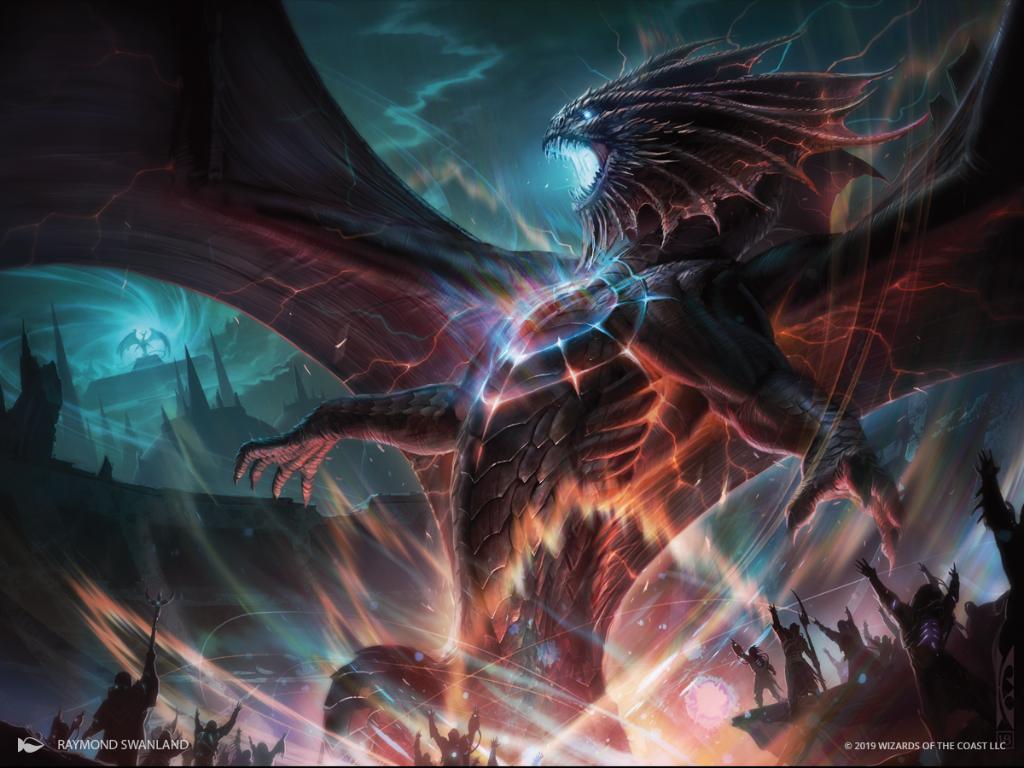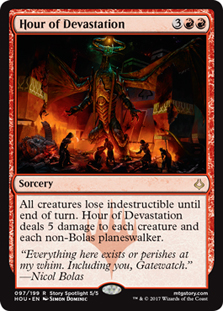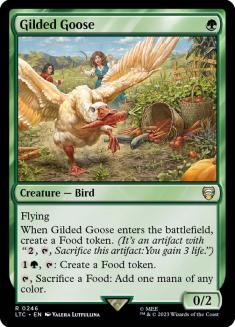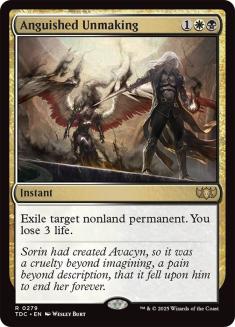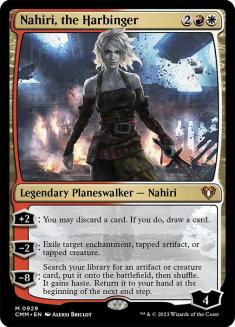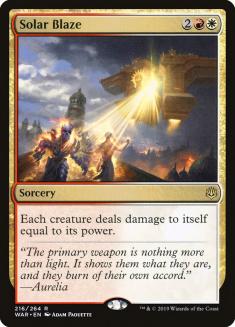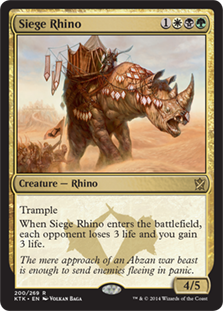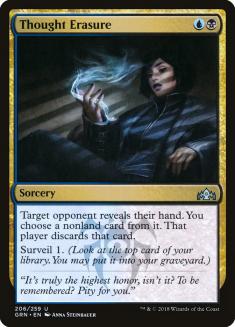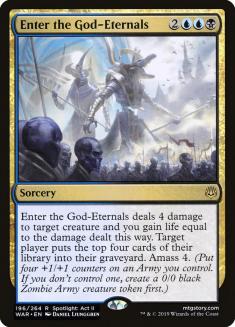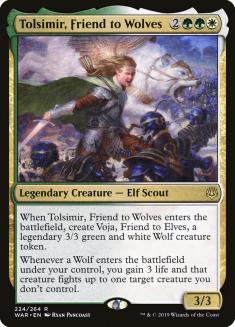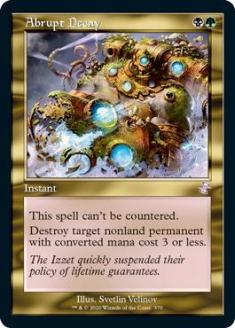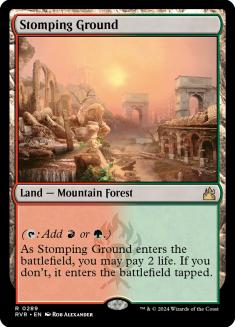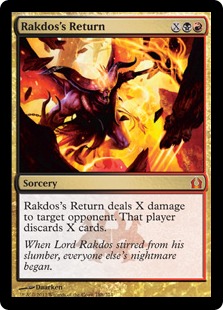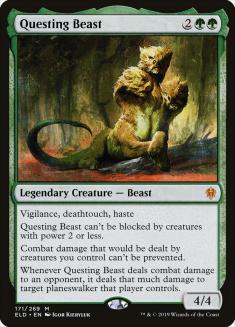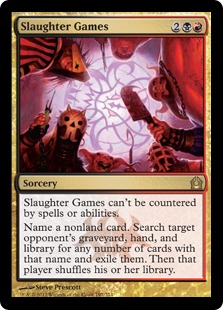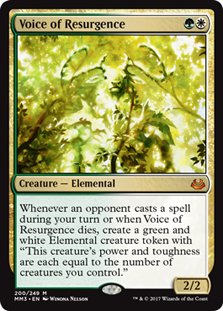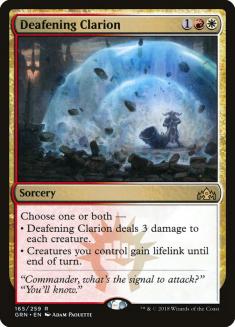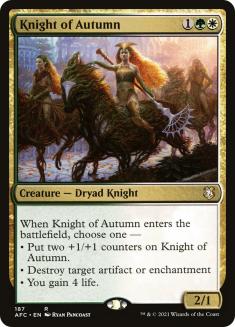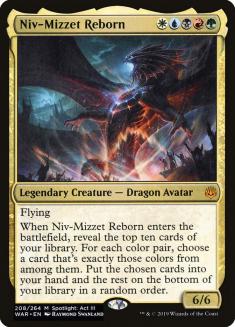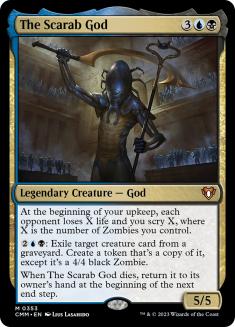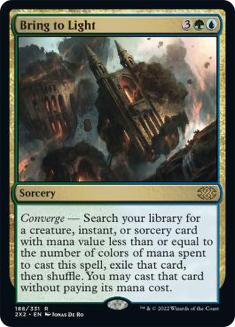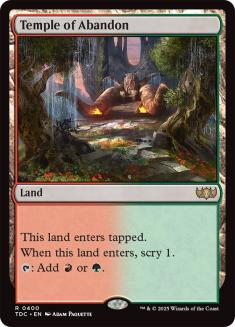Five-Color Niv-Mizzet decks did not perform well at either Players Tour Brussels or Players Tour Nagoya. However, I feel like Five-Color Niv-Mizzet is one of those decks where looking at the overall picture can be very misleading, as minute differences in the decklist can translate into a drastically different win rate.
Take, for example, a build that doesn’t play the single Hour of Devastation (which was most builds that I saw). I’d expect that player to lose several games across the tournament because they don’t have access to that one card, whereas a one card difference is hardly going to matter between builds of, say, Mono-Black Aggro. I felt that our list was very well tuned and our result with that specific list was around 65%, which isn’t absurd considering we were all good players but is much better than the 45% figure that has been throwing around.
Basically, I think a big part of Five-Color Niv-Mizzet’s bad performance was due to people playing suboptimal lists, so today I’m going to talk to you about what I consider to be a good list of the archetype and the process we used to get there.
Here is the list my group played:
Creatures (13)
Planeswalkers (6)
Lands (28)
Spells (13)

This is a deck whose goal is to play a quick Niv-Mizzet Reborn and then draw 2-3 cards and ride those to victory (contrary to popular belief, you don’t need to draw 5+ cards to win, which means you don’t need to make suboptimal deck choices just to diversify your Niv-Mizzet hits). It plays sort of as a hybrid between control and midrange, and drowns other slow decks in card advantage. Game 1 against certain uninteractive decks is tough, but you can sometimes steal a win with Slaughter Games or just a faster clock than they’re ready for, and you improve a lot versus all these decks after sideboarding.
Here are some explanations for our card choices:
There are several slots in the deck that you could call “flex slots” – cards that you can play or you can not play, depending on the rest of your build or what you like. I don’t think Hour of Devastation is one of those cards. It is a mandatory inclusion and if you don’t play it then your build is suboptimal. I think that, other than Niv-Mizzet Reborn, it’s the card you search for the most with Bring to Light.
Playing Hour of Devastation doesn’t preclude you from playing a different sweeper as well, but it has several advantages over the other sweepers that make it an important card even if you can’t find it with Niv-Mizzet. First, it doesn’t kill Niv-Mizzet Reborn, which is obviously very important. Second, it removes indestructible. There have been many formats where this would be irrelevant, but it comes up a lot in Pioneer. By having this clause, Hour of Devastation kills Selfless Spirit, Soulflayer, Heliod, Sun-Crowned, Hazoret, the Fervent and animated Darksteel Citadels. That’s just too many things.
This was probably the card I got the most questions about. Most players realized they wanted more than four Sylvan Caryatids, and Paradise Druid was the standard addition, but I think Gilded Goose is better. This is for a couple of reasons:
- The deck has a lot of lands that enter the battlefield tapped, and sometimes you have multiple in your hand. With Gilded Goose, you can play a Temple on Turn 1 and Fabled Passage + Gilded Goose on urn 2 (or two Temples)
- It enables potential Turn 3 Niv-Mizzet Reborns, which is impossible with the other version.
- It doesn’t die to Solar Blaze, which was our second sweeper of choice.
- It leaves behind a Food even if they kill it, which can sometimes be relevant against aggressive decks.
- It doesn’t die to Goblin Chainwhirler. Obviously it dies to a bunch of other things (such as Fatal Push or Wild Slash), but these are all cards they have to spend mana to play, whereas Chainwhirler is a card they’d play anyway and just happens to kill yours in the process.
Overall, I don’t think this is a clear-cut decision, as there are pros and cons to each card (for example Paradise Druid is better at attacking Teferi, Time Raveler, dodges more removal, and you can use it multiple turns in a row), but overall we thought GIlded Goose was the superior choice.
You need to have at least one card that can exile Uro, Titan of Nature’s Wrath or The Scarab God. Most people played Utter End, but we decided for Anguished Unmaking. The process that led us to this decision was very interesting but I believe ultimately incorrect.
Overall, I think you’d rather have Utter End versus aggressive decks and Anguished Unmaking versus control and combo, where the mana is more relevant than the three life. This seems like it should give the nod to Utter End, since it’s also strictly better every time you Bring to Light for it instead of drawing it, and that’s more often than when you actually draw it, but the key point for us here was that, against aggro decks, you’re sideboarding out whichever card this is anyway. So whichever card you play in this slot is going to be in your deck in less than half the games against aggro, but in all your games against control and combo – therefore, it makes sense to play the card that’s better in those matchups.
In practice, I think we underestimated just how big three life is. I had issues with the card several times in my matches, even post-sideboard versus decks like Simic Ramp, and so did some other members of our team. In the future, I’d play Utter End in that slot.
Nahiri, the Harbinger performed very well for us. The way this deck works is that it’s a pile of mana sources and then few spells that do anything, and Nahiri helps you find these spells and often acts as the one “business spell” you need. The ultimate is quite relevant and quick to get to (you often get Niv-Mizzet Reborn, but sometimes Uro, Titan of Nature’s Wrath or a creature you sideboarded in), the exile clause is relevant, getting rid of artifacts and enchantments is relevant, and grabbing it with Niv-Mizzet is also relevant, so basically all parts of this card matter. I would play two or three.
Solar Blaze I’m lukewarm about. It’s there because it’s a sweeper that doesn’t kill your mana producers, which is very valuable, but at the same time there are many creatures that dodge it, such as Monastery Swiftspear and Soul-Scar Mage in Mono-Red Aggro, Spell Queller and Empyrean Eagle in Azorius Spirits, Cavalier of Thorns and World Breaker in Mono-Green Ramp, and so on. I think overall I still like it more than something like Supreme Verdict, but it’s certainly an option to not include it.
We’re not playing this card and I can’t comprehend why people do. It doesn’t help with your game plan at all and you can’t get it from Niv-Mizzet Reborn.
The Mana Base
We spent a lot of time working on the mana base – after all, it’s one of the most important parts of the deck. We ended up playing more lands than most people and more Temples as well. We figured that, with 28 lands and seven mana creatures, we didn’t need the trilands as much, and we preferred having Temples to find more action because not finding enough action is one of the main ways you lose. This can be very relevant, for example, in the mirror match.
I certainly don’t think our mana base was perfect – it’s a very hard thing to theorize and you simply don’t get enough practice games to notice any small change convincingly – but these were the things we were trying to solve, in other of importance:
- We needed to have access to all colors of mana once we had five lands. If you ever have five lands and can’t cast Niv-Mizzet Reborn, that’s a disaster. The easiest way for this to happen is when you have two of the same two-colored lands and a basic that overlaps. Because of this, we made an effort to never play more than three copies of any land with the same color combination.
- We needed access to the right amount of sources. Obviously that’s subjective and we didn’t know how many sources we needed, but we figured we needed a lot of green (hands without green are almost never keeps), followed by blue and white, then black, then red. Blue had more early game cards than white, but a lot of your early game sideboard cards were white, so that had to be in consideration as well.
- We wanted to be able to cast our multicolored spells. If you have Overgrown Tomb and Hallowed Fountain, then that’s access to UWBG, but it doesn’t cast Abrupt Decay or Teferi, Time Raveler because the dual lands overlap. Compare that to having Godless Shrine and Breeding Pool, for example, which casts both spells.
In the end, I feel that we did our best to maximize the second and third issues while not infringing in our “never more than three multicolored lands of the same color combination” rule. For example, in an ideal world we’d play more Orzhov and Simic aligned lands (because of the gold cards) but there was no way to arrive at what we thought were the required mana symbols while not having more duplicated lands, so we had to suck it up.
The Sideboard
I believe that, of all the decks in the format, Five-Color Niv-Mizzet is the one that improves the most after sideboarding, to a pretty significant degree. This is for two main reasons:
First, your deck is full of specific bullets (such as Slaughter Games, Solar Blaze and so on), so you always have something very bad to remove. Other people might have bad cards too (stuff like Fatal Push), but some decks don’t have any card as bad as the ones you’re taking out.
Second, and most importantly, you just have access to your sideboard cards so much more often. For example, imagine Mono-Red is going to bring in one card against you – an Eidolon of the Great Revel. It’s only going to be impactful if they draw it, which is going to be in roughly 20% of the games. Now imagine you also bring in one card – Enter the God-Eternals. This is a card you’re also 20% to draw, but that you can also find with Niv-Mizzet Reborn and search for with Bring to Light. You’re both sideboarding in only one card, but, in practice, the number of games you play Enter the God-Eternals and it makes a difference is much, much larger than the number of games they have access to the card they sideboarded in. This is true for a large part of your sideboard slots, which is why your post-sideboard configuration is so good versus almost everyone.
There is a lot of variation in these slots, but we opted for four Thoughtseize and one Thought Erasure. We felt that the cheaper mana cost of Thoughtseize was simply more important than the fact that you could grab Thought Erasure from Niv-Mizzet Reborn. Mystic Dispute was a card that we tried and didn’t like. The deck taps out a lot, so it’s better to have a card you can play the turn before to force through your spells. Besides, getting two blue mana wasn’t often trivial (so for example you weren’t always able to play Teferi, Time Raveler + Mystical Dispute in the same turn even if you had four mana), and a lot of the decks you want Thoughtseize against have Teferi, Time Raveler as well (such as the mirror or Azorius Control) which means Mystical Dispute is sometimes a dead card. I’m very confident that the discard spells are better than Mystical Dispute.
Our original version of the deck had Tolsimir, Friend to Wolves, but the emergence of Torbran, Thane of Red Fell in Mono-Red lists made Enter the God-Eternals more appealing. On top of that, milling yourself for Uro, Titan of Nature’s Wrath is quite relevant, and it’s also a card you can bring in versus Dimir Inverter (I killed an opponent in the swiss with it after they played Inverter, for example). Overall I feel like these factors mean more than the fact that Tolsimir is easier to cast and can be searched for with Nahiri.
Sideboarding
Here’s how I would sideboard versus most of the top decks on the field:
VS Dimir Inverter
Out:
In:
This might seem like a random collection of cards to take out, and that’s because it is. We felt that the matchup became pretty grindy after sideboarding, so you tend to flood and don’t need that many mana sources, especially since they never interact with your mana creatures.
VS Mono-Red Aggro
Out (on the play):
In (on the play):
Out (on the draw):
In (on the draw):
VS Mono-Black Aggro
Out:
In:
VS Azorius Control
Out:
In:
VS Azorius/Bant Spirits
Out:
In:
Originally we were bringing in Voice of Resurgence versus Spirits, but I don’t think you can race them enough with it and it doesn’t block anything, so I haven’t been bringing it in.
VS Five-Color Niv-Mizzet
Out:
In:
Moving Forward
I thought our list was a very good version of the archetype, but whether the archetype is good or not is going to depend on what you expect to face. I believe this list is good versus all mono-colored aggressive decks (such as Mono-Red, Mono-Black, and Mono-White), and it’s also good versus other midrange builds (such as the Sultai Delirium deck that won the tournament). I also think you’re slightly favored versus Azorius Control – it’s bad in Game 1 but good in Games 2 and 3. I think it’s slightly unfavored versus Dimir Inverter (but only a little bit – you have a lot more game than you’d think because you also have an “I win” button in Slaughter Games), and then it’s unfavored versus Lotus Field decks, Azorius/Bant Spirits, Izzet Ensoul and Ramp (though I actually beat a Lotus Field, a Spirits and two Simic Ramp decks in the tournament, so it’s certainly not hopeless).
I would change very few things from our list. First, I would turn the Anguished Unmaking into an Utter End. Then, I would add swap the maindeck Solar Blaze for another Thoughtseize, as I think the control and combo decks are more popular than I originally expected. My list would look like this:
Creatures (13)
Planeswalkers (6)
Lands (28)
Spells (13)


